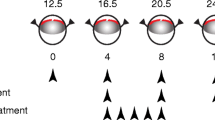Abstract
Background
Pigment epithelium-derived factor (PEDF)–derived 34-mer peptide (PEDF34, Asp44-Asn77) has anti-angiogenic activity but has limitations in clinical application because of an inverted bell–shaped dose-effect relationship and a short half-life. In this study, we attempted to mitigate these problems by mixing PEDF34 with type I collagen.
Methods
The anti-angiogenic activity of the PEDF34/atelocollagen mixture was evaluated by HUVEC tube formation assay and in a laser-induced choroidal neovascular (CNV) mouse model. PEDF34 and/or collagen were administrated using intravitreal injections or eye drops. CNV lesion size was quantified using FITC-dextran-perfused retinal whole mounts. Western blot analysis and inhibitor assays were used to define the action mechanisms of PEDF34 and the mixture.
Results
Collagen broadened the effective dose range of PEDF34 in the tube formation assay by > 250 times (from 0.2 to 50 nM). In the CNV model, five intravitreal injections of PEDF34 were required for therapeutic effect, whereas the mixture had a significant therapeutic effect following a single injection. Eye drops of the mixture showed significantly stronger CNV-suppressive effects than drops of PEDF34 alone. The anti-angiogenic activity of PEDF34 might be mediated by inhibition of ERK and JNK activation by VEGF, and collagen potentiated these effects.
Conclusions
Collagen can serve as a carrier and reservoir of PEDF34. PEDF peptide/collagen mixture is easy to prepare than conventional methods for maintaining the therapeutic effect of PEDF peptide.




Similar content being viewed by others
References
Lim LS, Mitchell P, Seddon JM, Holz FG, Wong TY (2012) Age-related macular degeneration. Lancet 379:1728–1738. https://doi.org/10.1016/S0140-6736(12)60282-7
Wong WL, Su X, Li X, Cheung CM, Klein R, Cheng CY, Wong TY (2014) Global prevalence of age-related macular degeneration and disease burden projection for 2020 and 2040: a systematic review and meta-analysis. Lancet Glob Health 2:e106–e116. https://doi.org/10.1016/S2214-109X(13)70145-1
Group CR, Martin DF, Maguire MG, Ying GS, Grunwald JE, Fine SL, Jaffe GJ (2011) Ranibizumab and bevacizumab for neovascular age-related macular degeneration. N Engl J Med 364:1897–1908. https://doi.org/10.1056/NEJMoa1102673
Dawson DW, Volpert OV, Gillis P, Crawford SE, Xu H, Benedict W, Bouck NP (1999) Pigment epithelium-derived factor: a potent inhibitor of angiogenesis. Science 285:245–248
Bhutto IA, McLeod DS, Hasegawa T, Kim SY, Merges C, Tong P, Lutty GA (2006) Pigment epithelium-derived factor (PEDF) and vascular endothelial growth factor (VEGF) in aged human choroid and eyes with age-related macular degeneration. Exp Eye Res 82:99–110. https://doi.org/10.1016/j.exer.2005.05.007
Apte RS, Barreiro RA, Duh E, Volpert O, Ferguson TA (2004) Stimulation of neovascularization by the anti-angiogenic factor PEDF. Invest Ophthalmol Vis Sci 45:4491–4497. https://doi.org/10.1167/iovs.04-0172
Amaral J, Becerra SP (2010) Effects of human recombinant PEDF protein and PEDF-derived peptide 34-mer on choroidal neovascularization. Invest Ophthalmol Vis Sci 51:1318–1326. https://doi.org/10.1167/iovs.09-4455
Park K, Lee K, Zhang B, Zhou T, He X, Gao G, Murray AR, Ma JX (2011) Identification of a novel inhibitor of the canonical Wnt pathway. Mol Cell Biol 31:3038–3051. https://doi.org/10.1128/MCB.01211-10
Elahy M, Baindur-Hudson S, Cruzat VF, Newsholme P, Dass CR (2014) Mechanisms of PEDF-mediated protection against reactive oxygen species damage in diabetic retinopathy and neuropathy. J Endocrinol 222:R129–R139. https://doi.org/10.1530/JOE-14-0065
Craik DJ, Fairlie DP, Liras S, Price D (2013) The future of peptide-based drugs. Chem Biol Drug Des 81:136–147. https://doi.org/10.1111/cbdd.12055
He X, Cheng R, Benyajati S, Ma JX (2015) PEDF and its roles in physiological and pathological conditions: implication in diabetic and hypoxia-induced angiogenic diseases. Clin Sci (Lond) 128:805–823. https://doi.org/10.1042/CS20130463
Becerra SP, Perez-Mediavilla LA, Weldon JE, Locatelli-Hoops S, Senanayake P, Notari L, Notario V, Hollyfield JG (2008) Pigment epithelium-derived factor binds to hyaluronan. Mapping of a hyaluronan binding site. J Biol Chem 283:33310–33320. https://doi.org/10.1074/jbc.M801287200
Meyer C, Notari L, Becerra SP (2002) Mapping the type I collagen-binding site on pigment epithelium-derived factor. Implications for its antiangiogenic activity. J Biol Chem 277:45400–45407. https://doi.org/10.1074/jbc.M208339200
Yasui N, Mori T, Morito D, Matsushita O, Kourai H, Nagata K, Koide T (2003) Dual-site recognition of different extracellular matrix components by anti-angiogenic/neurotrophic serpin, PEDF. Biochemistry 42:3160–3167. https://doi.org/10.1021/bi0206558
Friess W (1998) Collagen--biomaterial for drug delivery. Eur J Pharm Biopharm 45:113–136
Cai J, Chen Z, Ruan Q, Han S, Liu L, Qi X, Boye SL, Hauswirth WW, Grant MB, Boulton ME (2011) Gamma-secretase and presenilin mediate cleavage and phosphorylation of vascular endothelial growth factor receptor-1. J Biol Chem 286:42514–42523. https://doi.org/10.1074/jbc.M111.296590
Cai J, Jiang WG, Grant MB, Boulton M (2006) Pigment epithelium-derived factor inhibits angiogenesis via regulated intracellular proteolysis of vascular endothelial growth factor receptor 1. J Biol Chem 281:3604–3613. https://doi.org/10.1074/jbc.M507401200
Pisal DS, Kosloski MP, Balu-Iyer SV (2010) Delivery of therapeutic proteins. J Pharm Sci 99:2557–2575. https://doi.org/10.1002/jps.22054
Li H, Tran VV, Hu Y, Mark Saltzman W, Barnstable CJ, Tombran-Tink J (2006) A PEDF N-terminal peptide protects the retina from ischemic injury when delivered in PLGA nanospheres. Exp Eye Res 83:824–833. https://doi.org/10.1016/j.exer.2006.04.014
Seery CM, Davison PF (1991) Collagens of the bovine vitreous. Invest Ophthalmol Vis Sci 32:1540–1550
Liu X, Chen HH, Zhang LW (2013) Potential therapeutic effects of pigment epithelium-derived factor for treatment of diabetic retinopathy. Int J Ophthalmol 6:221–227. https://doi.org/10.3980/J.ISSN.2222-3959.2013.02.22
Vigneswara V, Esmaeili M, Deer L, Berry M, Logan A, Ahmed Z (2015) Eye drop delivery of pigment epithelium-derived factor-34 promotes retinal ganglion cell neuroprotection and axon regeneration. Mol Cell Neurosci 68:212–221. https://doi.org/10.1016/j.mcn.2015.08.001
Acknowledgements
We would like to thank Editage (www.editage.co.kr) for English language editing.
Funding
This study was funded by the 2016 Inje University Research Grant.
Author information
Authors and Affiliations
Corresponding author
Ethics declarations
Conflict of interest
The authors declare that they have no conflict of interest.
Ethical approval
All animals were treated in accordance with the ARVO Statement for the Use of Animals in Ophthalmic and Vision Research. Animal experiments were examined and approved by the Institutional Animal Care and Use Committee of INJE University (Protocol No. 2016-007).
Additional information
Publisher’s note
Springer Nature remains neutral with regard to jurisdictional claims in published maps and institutional affiliations.
Rights and permissions
About this article
Cite this article
Kim, H.W., Roh, KH., Kim, S.W. et al. Type I pig collagen enhances the efficacy of PEDF 34-mer peptide in a mouse model of laser-induced choroidal neovascularization. Graefes Arch Clin Exp Ophthalmol 257, 1709–1717 (2019). https://doi.org/10.1007/s00417-019-04394-z
Received:
Revised:
Accepted:
Published:
Issue Date:
DOI: https://doi.org/10.1007/s00417-019-04394-z




